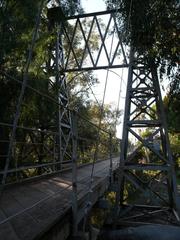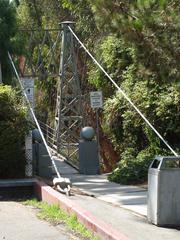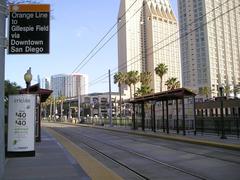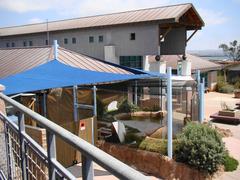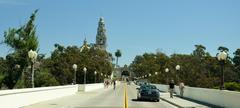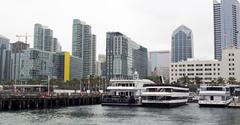
Spruce Street Suspension Bridge in San Diego: Visiting Hours, Tickets, and Guide
Date: 18/07/2024
Introduction
San Diego, a city renowned for its scenic beauty and rich history, is home to numerous landmarks that narrate its journey through time. One such landmark is the Spruce Street Suspension Bridge, a testament to early 20th-century engineering and the city’s spirit of innovation. Built in 1912 by the visionary engineer Edwin Capps, the bridge was designed to overcome the geographical challenges posed by the canyon, linking the burgeoning neighborhoods of Banker’s Hill and Logan Heights (Discover the Spruce Street Suspension Bridge). Its unique hybrid design, combining suspension and cantilever elements, makes it a marvel of engineering and a beloved symbol of San Diego’s past and present.
Table of Contents
- [A Bridge Through Time](#a-bridge-through-timea-bridge-through-time)
- [Early Beginnings (1900s-1910s)](#early-beginnings-1900s-1910searly-beginnings-1900s-1910s)
- [A City Connects (1912-1930s)](#a-city-connects-1912-1930sa-city-connects-1912-1930s)
- [Facing Challenges (1940s-1970s)](#facing-challenges-1940s-1970sfacing-challenges-1940s-1970s)
- [Preservation and the Future (1980s-Present)](#preservation-and-the-future-1980s-presentpreservation-and-the-future-1980s-present)
- [Visiting Hours and Tickets](#visiting-hours-and-ticketsvisiting-hours-and-tickets)
- [Travel Tips](#travel-tipstravel-tips)
- [FAQ](#faqfaq)
- [Call to Action](#call-to-actioncall-to-action)
A Bridge Through Time
The Spruce Street Suspension Bridge, a beloved San Diego landmark, boasts a rich history interwoven with the city’s growth and development. Its story is one of ambition, innovation, and resilience, reflecting San Diego’s own journey to becoming the vibrant city it is today.
Early Beginnings (1900s-1910s)
The idea for a bridge across the canyon where Spruce Street now stands emerged in the early 1900s. San Diego, then a burgeoning city, sought to connect its growing neighborhoods and facilitate easier movement. The canyon, however, presented a significant geographical challenge.
Edwin Capps, a prominent engineer known for his work on the Coronado Ferry landing, answered the call. His vision was a suspension bridge, a relatively new technology at the time, which he believed could elegantly span the canyon’s expanse. Capps’ design, approved in 1911, called for a 375-foot-long suspension bridge, supported by two concrete towers and held aloft by steel cables. The bridge deck, made of wood, would hang gracefully below, offering stunning views of the canyon.
Construction began in 1912, a testament to the city’s ambition and belief in Capps’ vision. The project, however, was not without its challenges. The remote location and the need to transport heavy materials across the canyon proved to be logistical hurdles.
A City Connects (1912-1930s)
Despite the difficulties, the Spruce Street Suspension Bridge was completed in 1912, marking a pivotal moment in San Diego’s development. The bridge, a marvel of engineering for its time, quickly became a vital artery, connecting the neighborhoods of Banker’s Hill and Logan Heights.
More than just a means of crossing the canyon, the bridge became a symbol of the city’s progress and its embrace of innovation. It stood as a testament to the spirit of San Diego, demonstrating its ability to overcome geographical obstacles and connect its communities.
The bridge’s early years were marked by a steady increase in traffic as San Diego continued to grow. Automobiles, still a relatively new invention, began sharing the bridge with horse-drawn carriages and pedestrians, reflecting the changing times.
Facing Challenges (1940s-1970s)
The mid-20th century brought new challenges for the Spruce Street Suspension Bridge. The rise of the automobile led to a significant increase in traffic volume and weight, putting a strain on the bridge’s aging structure.
The original wooden deck, while aesthetically pleasing, was not designed for the heavy loads of modern vehicles. Concerns about the bridge’s long-term viability began to surface, prompting the city to explore options for its future.
In the 1970s, a major renovation project was undertaken to address the bridge’s structural concerns and ensure its continued safety. The most significant change was the replacement of the original wooden deck with a more durable steel grid deck. While the new deck addressed the structural concerns, it significantly altered the bridge’s aesthetic, a point of contention among some residents who felt it detracted from the bridge’s historic charm.
Preservation and the Future (1980s-Present)
Despite the changes, the Spruce Street Suspension Bridge remained a beloved landmark, its silhouette etched against the San Diego skyline. Recognizing its historical and cultural significance, the city committed to its preservation. In the 1980s, the bridge was designated as a historical landmark, ensuring its protection and recognizing its importance to the city’s heritage. Further renovations and maintenance projects were undertaken to preserve its structural integrity and enhance its safety.
Today, the Spruce Street Suspension Bridge stands as a proud symbol of San Diego’s past, present, and future. It continues to serve as a vital pedestrian link, offering breathtaking views of the canyon and the city beyond. The bridge’s story is a testament to the power of human ingenuity, the importance of community connections, and the enduring allure of a city’s history. As San Diego continues to evolve, the Spruce Street Suspension Bridge remains a steadfast reminder of its roots and a symbol of its enduring spirit.
Visiting Hours and Tickets
The Spruce Street Suspension Bridge is open to the public daily from 6 AM to 10 PM. Entrance is free, making it an accessible attraction for all visitors. While there are no ticket requirements, it’s always best to check the official San Diego city website for any updates or special events.
Travel Tips
- Best Time to Visit - Early mornings or late afternoons are ideal to avoid crowds and enjoy the serene views.
- Photography - The bridge offers numerous picturesque spots, especially during sunrise or sunset. Don’t forget to bring your camera!
- Accessibility - The bridge is pedestrian-only, so wear comfortable walking shoes. The paths leading to the bridge are fairly accessible, but be prepared for some uneven terrain.
- Nearby Attractions - The bridge is located close to Balboa Park, the San Diego Zoo, and the historic Gaslamp Quarter. Consider combining your visit with these nearby attractions.
FAQ
Q: What are the visiting hours for the Spruce Street Suspension Bridge? A: The bridge is open daily from 6 AM to 10 PM.
Q: How much are tickets for the Spruce Street Suspension Bridge? A: There are no tickets required; entrance is free.
Q: Is the Spruce Street Suspension Bridge accessible for all visitors? A: Yes, but be prepared for some uneven terrain on the paths leading to the bridge.
Call to Action
Explore more about San Diego’s historical sites and landmarks by visiting our related articles. Don’t forget to follow us on social media for the latest updates and travel tips. Download the Audiala mobile app for an interactive experience and guided tours of San Diego’s best attractions.
Conclusion
The Spruce Street Suspension Bridge stands as a resilient and iconic symbol of San Diego’s historical and cultural heritage. From its early days overcoming the logistical challenges of construction to its role in connecting communities, the bridge has been a vital part of the city’s fabric. Despite facing structural challenges over the decades, including the need for significant renovations, the bridge has been preserved and continues to serve as a pedestrian link and a picturesque landmark. Today, it offers not only a functional crossing but also a window into the history and spirit of San Diego, attracting visitors from all over who come to marvel at its engineering and enjoy the stunning views it offers. Whether for its historical significance, architectural beauty, or the serene experience it provides, the Spruce Street Suspension Bridge remains a must-visit destination in San Diego (Discover the Spruce Street Suspension Bridge) (Exploring the Historic Spruce Street Suspension Bridge).

